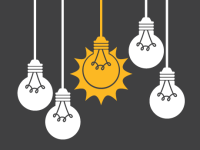Reflecting on Reflection: A Habit of Mind
Terry Heick looks at what reflection is, how it works as both a private and shared activity, and why teachers need it in their toolkit.
Reflection is a fundamental tenet of learning, and therefore a fundamental part of teaching. Why it happens is a matter of humility. But how and when it happens -- and with whom -- is less clear. This is partly because there are multiple sides to reflection -- length, width, and depth. To reflect means to look back at how something "went" in all of its available parts and patterns:
- Causes and effects
- Comparisons and contrast
- Strengths and weakness
- Characteristics
- How close it came to expectations
- Your emotions.
You're thinking, "I planned this, and it went like this, and now I think this."
Practice and Procedure
Reflection sounds like an abstract idea, something unspecific, and even a little mystical. Something we do in the shower or on the drive home, when no one's around and we're free to roam in our own minds. It's definitely true that reflection comes most effortlessly, and in its purest and rawest forms, in those circumstances when our minds are not otherwise engaged.
Reflection isn't a single thing, a box to check in some elliptical cycle of learning. It's as much a matter of self-awareness, humility, and affection as it is of timing, sequence, and procedure.
With this kind of examination laid out, the practice of reflection is more fruitful, which is where the non-abstractions come in -- the tangible tools, processes, and partners of reflection that allow us to socialize ourselves and our teaching, and benefit from concrete practice of reflection.
An Example: Twitter as a Trigger
I use Twitter as a matter of both practice and thought. There are mechanical actions that lead to thought, and the other way around. I bring out my tablet or sit down at my PC, log onto Twitter, skim my feed, check mentions and messages, respond to tweets if I feel like it. These are inputs. The output, if I get it just right, is reflection.
If I read a tweet, interpret what I believe to be its meaning, find relevance in its message, and think even briefly about how I relate to it and how it relates to me, I'm approaching reflection.
When reflection happens on Twitter, it's a matter of practice, habit, and a tendency toward the kind of thought that promotes change in your teaching. But this Twitter moment is just an easy example about the dimensions of reflection: how, when, and who.
How Does Reflection Happen?
A recent blogging challenge on TeachThought encouraged teachers to use a series of writing prompts. Daily, these were about looking at the ins and outs of teaching. More broadly, they were about teachers building both their capacity and tendency to reflect.
There is also a #reflectiveteacher hashtag to carry that conversation from beyond your blog into a larger space where it has a chance for more visibility. But more importantly, the tweeting and hashtagging is about extending and socializing the practice of reflection. It's not about the post, but about the vulnerability that comes with reflection -- being honest, transparent, and then standing on your own.
The reflection actually starts much earlier, alone, in your own mind after something happens. Then it often happens with a friend, colleague, loved one or maybe even a student. Then you're likely to reflect again, alone, now pushed farther in your thinking by that sharing. Writing about it again, and then sharing that with others, makes the reflection more complex and more personal.
Alone > Together > Alone
Reflection, among other patterns, often happens alone (slow and passive), together (immediate and active), and then alone again (slow and passive again).
While Teaching > After Teaching > After School
Reflection is also a matter of timing. It can happen at any time, but no sooner than the event -- the lesson, assessment, meeting, or Socrative Discussion -- begins taking place.
While teaching, how is it going really? What adjustments seem necessary? What's most important here? Then immediately after, in a habits of mind sense, how did it go (evaluation), and how do I know (data)? After school, now that I have some distance from the event, what do I think? What's lingering? What should I do differently next time? What would students say if they were right here next to me?
Students > Colleagues > PLN
And then, with whom should I reflect? Students? Colleagues? Professional Learning Networks? My spouse? How is each episode different? What's worth talking about or forgetting?
How can I see reflection as a way of teaching, so that it's impossible to separate out and itemize, but is instead a moment-by-moment thing that is always with me like a heartbeat?
How do you use reflection in your teaching practice?
